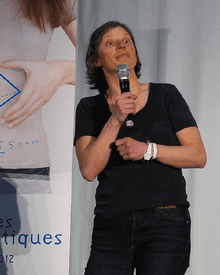Laure Saint-Raymond
Laure Saint-Raymond (born 1975) is a French mathematician, and a professor of mathematics at École Normale Supérieure de Lyon. She is known for her work in partial differential equations, and in particular for her contributions to the mathematically rigorous study of the connections between interacting particle systems, the Boltzmann equation, and fluid mechanics. In 2008 she was awarded the European Mathematical Society Prize, with her citation reading:
Saint-Raymond is well known for her outstanding results on nonlinear partial differential equations in the dynamics of gases and plasmas and also in fluid dynamics. [...] Saint-Raymond is at the origin of several outstanding and difficult results in the field of nonlinear partial differential equations of mathematical physics. She is one of the most brilliant young mathematicians in her generation.
Laure Saint-Raymond | |
|---|---|
 Laure Saint-Raymond in 2012 | |
| Born | August 4, 1975 |
| Nationality | France |
| Alma mater | École Normale Supérieure Paris Diderot University |
| Awards | EMS Prize (2008) Satter Prize (2009) Fermat Prize (2015) Bôcher Prize (2020) |
| Scientific career | |
| Fields | Mathematics |
| Institutions | École Normale Supérieure de Lyon |
| Doctoral advisor | François Golse |
Biography
Laure Saint-Raymond studied in Paris, entering École Normale Supérieure in 1994. In 1996, she received a Master's degrees in plasma physics from Versailles Saint-Quentin-en-Yvelines University and in applied mathematics from Pierre and Marie Curie University. In 2000 she finished her Ph.D. in applied mathematics at Paris Diderot University, under the supervision of François Golse.
She worked for two years for the French National Centre for Scientific Research, and was named in 2002 full professor of mathematics at the Pierre and Marie Curie University at the age of 27. In 2007, she moved to the École Normale Supérieure, and is now professor at the École Normale Supérieure de Lyon.
She is the mother of six children.[1]
Awards and honors
Her work has been recognized by many prestigious international awards, notably the Fermat Prize and the Bôcher Memorial Prize. In 2013, she was elected to the French Academy of Sciences, and in 2014 was an invited speaker at the International Congress of Mathematicians.[2] A partial list of her awards and honors include:
- 2003 : Louis Armand Prize of the French Academy of Sciences [3]
- 2004 : Claude-Antoine Peccot Award of Collège de France
- 2004 : Pius XI Medal of the Pontifical Academy of Sciences [4]
- 2006 : The Best Paper prize of the SIAM Activity Group on Analysis of PDE[5] for:
- (with François Golse) "The Navier-Stokes limit of the Boltzmann equation for bounded collision kernels." Invent. Math. 155 (2004), no. 1, 81–161.
- 2006 : Prize of the City of Paris for Young Scientists (joint with Isabelle Gallagher) [6]
- 2008 : Prize of the European Mathematical Society [7]
- 2009 : Ruth Lyttle Satter Prize in Mathematics of the American Mathematical Society[8] for:
- (with François Golse) "The Navier-Stokes limit of the Boltzmann equation for bounded collision kernels." Invent. Math. 155 (2004), no. 1, 81–161.
- "Convergence of solutions to the Boltzmann equation in the incompressible Euler limit." Arch. Ration. Mech. Anal. 166 (2003), no. 1, 47–80.
- 2011 : Irène Joliot-Curie Prize of the "Young Scientist Woman"[9][10]
- 2013 : Elected to the French Academy of Sciences (on December 10, 2013)[11]
- 2015 : Fermat Prize[12] for:
- the development of asymptotic theories of partial differential equations, including the fluid limits of rarefied flows, multiscale analysis in plasma physics equations and ocean modeling, and the derivation of the Boltzmann equation from interacting particle systems.
- 2020: Bôcher Memorial Prize for:
- her transformative contributions to kinetic theory, fluid dynamics, and Hilbert's sixth problem
Research
In 2009, her work was summarized by the Satter Prize committee as:
Her research has focused on the study of problems in mathematical physics, including the Boltzmann equation and its fluid dynamic limits, the Vlasov-Poisson system and its gyrokinetic limit, and problems of rotating fluids coming from geophysics. Her most striking work concerns the study of the hydrodynamic limits of the Boltzmann equation in the kinetic theory of gases, where she answered part of a question posed by Hilbert within the framework of his sixth problem.
Major publications
- Golse, François; Saint-Raymond, Laure. The Navier-Stokes limit of the Boltzmann equation for bounded collision kernels. Invent. Math. 155 (2004), no. 1, 81–161.
- Saint-Raymond, Laure. Hydrodynamic limits of the Boltzmann equation. Lecture Notes in Mathematics, 1971. Springer-Verlag, Berlin, 2009. xii+188 pp. ISBN 978-3-540-92846-1
References
- "Other interview".
- "ICM 2014 Invited Speakers". Archived from the original on 2013-07-18.
- Citation Archived 2014-07-28 at the Wayback Machine
- Citation
- "Citation". Archived from the original on 2015-12-27. Retrieved 2014-07-23.
- Communication on the City of Paris website Paris
- Article that appeared in Gazette of the Société mathématique de France
- Communication of the American Mathematical Society
- 2011 Irène Joliot-Curie Prize.
- Announcement
- Announcement Archived 2014-04-27 at the Wayback Machine
- Fermat Prize 2015